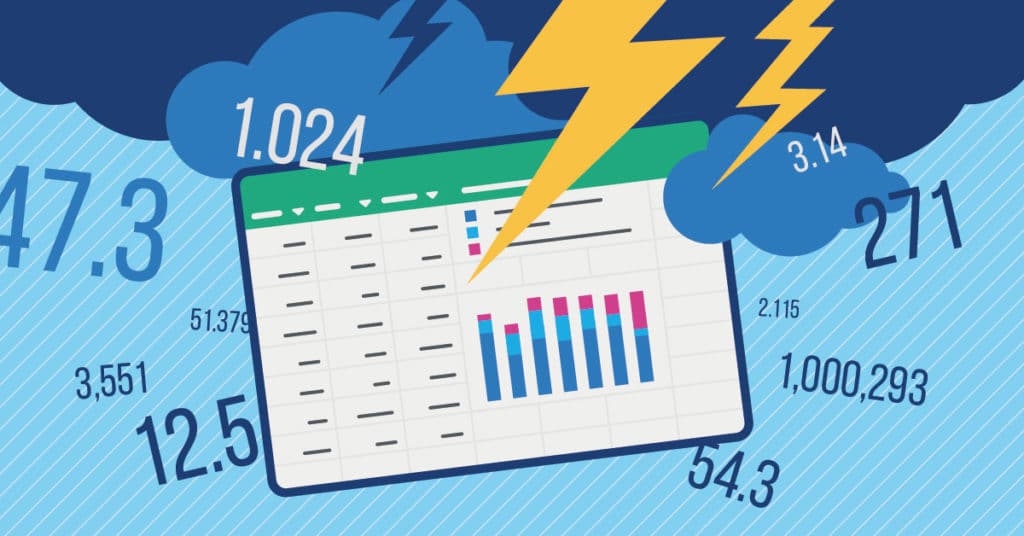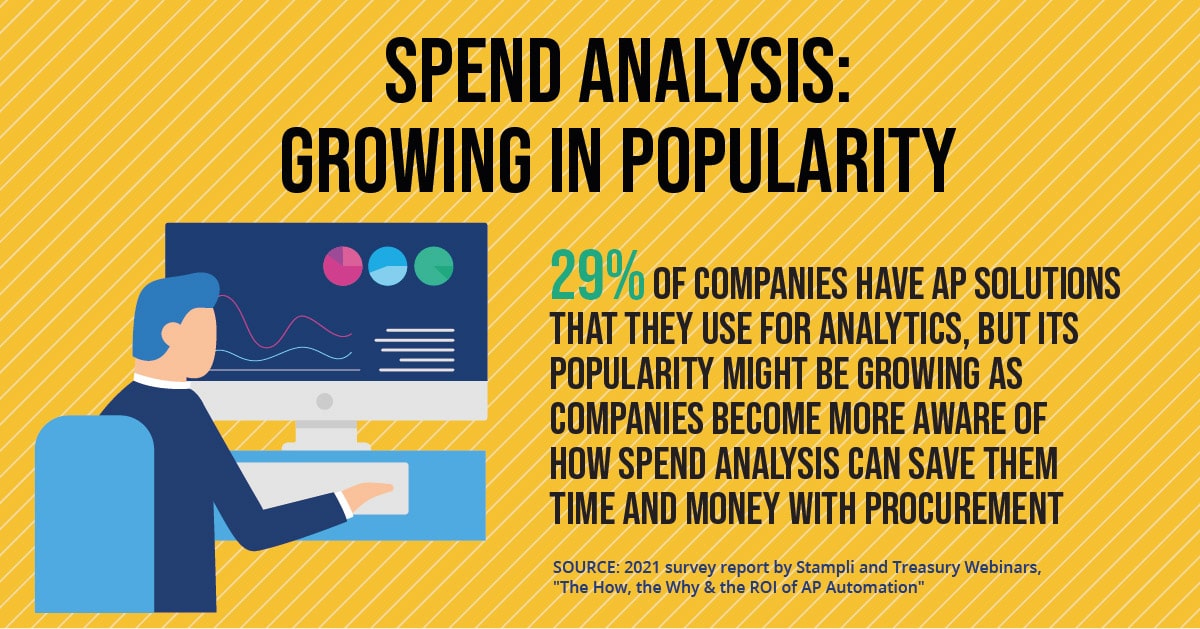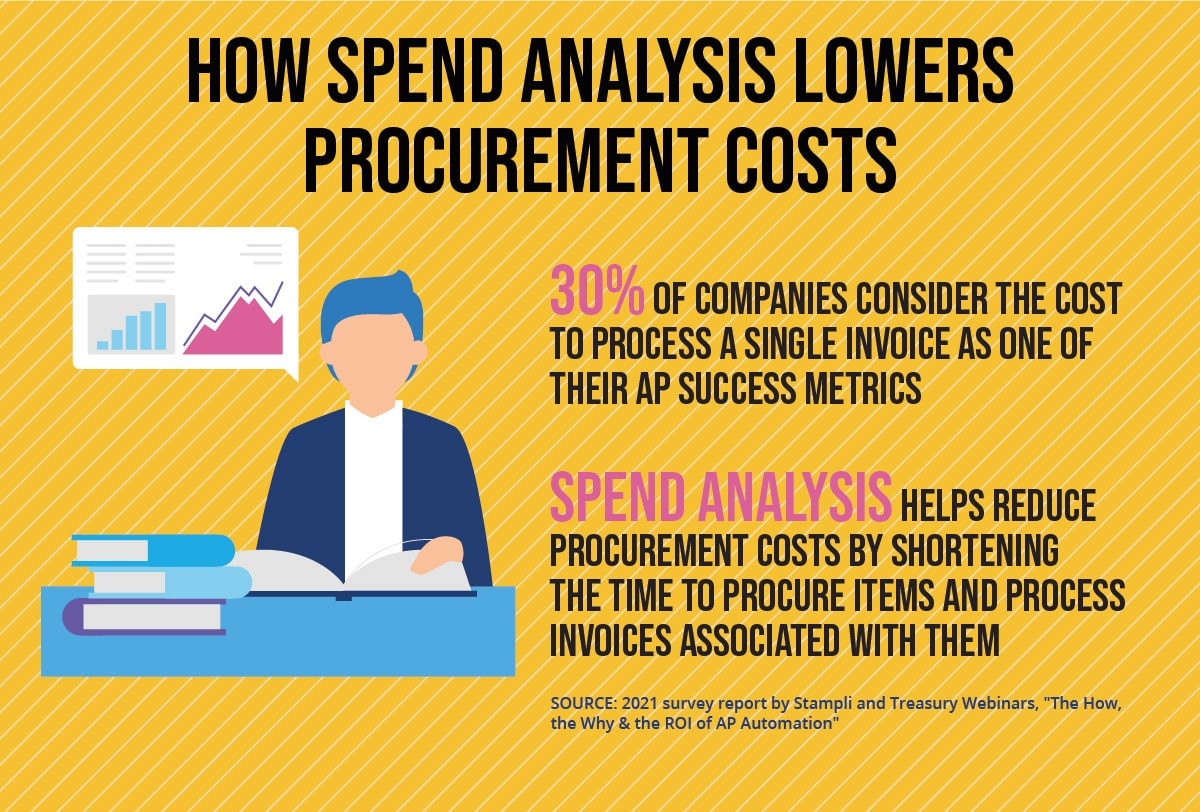How to Leverage Data and Reduce Procurement Costs with Spend Analysis

In a constantly moving business world, it can be easy for companies to lose sight of their spending.
After all, gauging the costs to do business can seem complex, time consuming, and sometimes like a fool’s errand. For some companies, the thinking might go that it’s better to focus on providing the best possible product or service and not to get too deep into the weeds debating how or when they’re spending money. Maybe they fear they’ll inadvertently cut an expense that’s working fine.
It doesn’t have to be this way, however.
Today, we’ll explore how companies can do spend analysis in a way that strengthens their bottom line, offering potential savings of time and money while improving working relationships with suppliers. We’ll also look at how Stampli helps in this process.
Spend Analysis Basics
Distinct from more rudimentary expenses, spend management, or budgeting, spend analysis takes a deep look at how a company is spending money and whether things could be done differently.
As such, spend analysis pulls in data from various sources within a company from its general ledger, ERP, credit card statements, and more. This data is then collated, placed into different buckets in preparation for analysis, and thoroughly reviewed.
Spend analytics data used can include procurement or e-procurement costs for individual departments or vendors that do business with multiple departments across companies. The data may also include a mixture of direct and indirect spends.

In some ways, spend analysis appears to be an up-and-coming part of accounts payable work. In a 2021 survey report by Stampli and Treasury Webinars, “The How, the Why & the ROI of AP Automation” respondents offered a range of AP solution functionality that their companies were using, with analytics ranked as only the fifth-most popular tool. Certainly, many more companies are still to discover how their AP platforms can help enable better spend analysis.
But, as we’ll explore more in the next section, spend analysis offers an assortment of benefits for companies willing to undertake it.
Steps for Performing Spend Analysis
There isn’t one single prescribed way to perform a spend analysis, with companies possibly wanting to adjust the methods and frequency, in order to get the best possible outcomes.
That said, one simple way a company can do a spend analysis: gather spending info, and consult data sources related to company invoices.
In a 2021 survey report by Stampli and Treasury Webinars, AP Today: Bottlenecks, Benchmarks & Best Practices, 44% of companies assigned invoices by department, while the rest did it depending on location, vendor, business unit, random assignment, or by amount.
It can be tricky to gather everything for companies that lack AP automation platforms which can centralize and store financial data.
- Cleaning the data allows companies to standardize the format across the different sources so that everything can be assimilated into one master dashboard or spreadsheet. This might sound wonkish, but financial platforms will sometimes offer slightly different formats between their different products. For instance, the bank account and credit card statements online for a major banking institution don’t have equal numbers of fields. Trying to merge each statement into a single spreadsheet can create discrepancies.
- Consider grouping data by categories or subcategories, such as internal departments, locations, suppliers, or more. There doesn’t seem to be a hard and fast rule on this and the categorization more about what spend data or KPIs a company is looking to zero in on. The category management and taxonomy can be adjusted as well as a company performs subsequent spend analyses.
- Perform the actual analysis and prepare for presentation, which can include top line reports, data visualizations, or more.
- Arguably most importantly, repeat steps 1-4 at regular intervals. Spend analysis can become much more acute when frequently revisited.
Why to Avoid Manual Spend Analysis
Without the right spend analysis tools in place, spend analysis can be a Sisyphean ordeal. If a company wants a useful spend analysis but most of their financial records haven’t been digitized, they could wind up practically having to do the work of an audit. It’s enough to make a company almost want to forgo doing a spend analysis.
On the other hand, with the right tools, the time for a business to conduct a spend analysis can be greatly reduced. Systems like AP automation platforms or virtual payment card systems can do much of the heavy lifting when it comes to data aggregation and even cleaning. The time for an accountant or analyst can be saved for the more high-level assessments.
3 Reasons You Need Spend Analysis
Now that we have a few basics of spend analysis established, let’s look at why it’s good for companies to make sure they’re regularly doing it. There are numerous reasons to consider, and here are three of the most important.
1. Lower Procurement Costs
When a company flies blindly with its procurement spend analysis, costs the firm might not be noticing can start to accumulate.
- Extra fees or missed early payment discounts
- Less than strategic sourcing strategy
- Staff time spent on extra steps in the supply chain or sourcing
- Procurement professionals dealing with excessive calls from vendors who might be anxious about when their payment is coming through
There can also be headaches associated with contract management, if a once-solid sourcing strategy is no longer effective, and supplier management problems start to compound.

Procurement costs, which can include AP expenses, are one of the most important AP success metrics, with 30% of respondents in a 2021 survey report by Stampli and Treasury Webinars, Drivers of AP Success: Metrics, Collaboration, Influence citing the costs to process a single invoice as a key metric.
Spend analysis solutions can help to achieve cost reductions in procurement in a number of ways:
- It can shorten the cycle time needed to obtain goods from suppliers
- Reduce the time required to process invoices
- Spend analysis can lead to optimization of payment terms
The procurement process will be easier and procurement teams can find other focuses for their time, thanks to the savings opportunities. It’s all part of an effective sourcing strategy.
2. Streamlined Operations
Business expenses can easily become bloated over time, like a beleaguered Hollywood production long past budget and with no end for spending in sight. And in both scenarios, a lot of unnecessary operations and costs will wind up on the books, serving no good purpose than to consume revenue.
Spend analysis trims away non-essential expenses, reducing waste, streamlining operations, and improving decision making. Especially in troubled or uncertain economic times, the spend analysis process is great for helping companies attain cost savings, bolster cash flow, and to meet customer needs.
3. Spend Analysis Coupled With Data Can Be Predictive
As a financial professional told PYMNTS.com, mere spend analysis actually isn’t enough. In recent years, the COVID-19 pandemic has increased interest in what the professional termed “active risk management,” he explained. “Savings [has been] on top of the procurement agenda, and an economic downturn has even increased the need for tools to manage a savings pipeline, and measure savings achieved.” he said.
This isn’t to knock spend analysis or say that it shouldn’t be part of a business’s arsenal of initiatives. The key is for companies to ensure that spend analysis is done in conjunction with the most up-to-date and accurate financial data.
“If an organization does not have a single source of truth for the numbers, people form their own views by collecting data in their own way from their own sources.” the financial professional told PYMNTS.com. “They form their own view based on ‘their’ number, which can significantly vary [based] on what others in the organization might have been looking at.”
For spend analysis to function optimally, it’s vital to have data easily accessible to anyone within an organization that needs it. Data management (which can be done in part by AI with the help of an analytics solution that makes use of machine learning) is also vital for gleaning actionable insights and identifying spending patterns. This is where partners like Stampli come in.
How Stampli Card Paves the Way for Better Spend Analysis
When a company wants to supercharge its spend analysis, one great way to do this is by turning to Stampli Card. Stampli’s virtual payment card solution makes it so that companies can do spend analysis before transactions even occur, by pre-classifying transaction types.
Here are a few more ways that Stampli Card will improve spend analysis.
Strong Controls to Prevent Unauthorized Spend
One great thing about virtual cards, which had been used by 61% of respondents in a 2021 survey report by Stampli and Treasury Webinars, How & Why Companies Choose Payment Types is that they can be individualized for every transaction.
For example, say if a traveling salesperson has a hotel bill for $179 with taxes and fees (which might be wishful thinking in certain American cities these days), a virtual card can be created for this person that allows them to spend up to a specific amount. After the transaction is completed, the card will no longer work for additional transactions.
This prevents a card from falling into rogue hands and being used for a bunch of unauthorized purchases or maverick spending. This type of card use also leads to cleaner and more useful spend data, since it’s less likely to be corrupted with fraudulent charges. With payments fraud still plaguing many companies, virtual cards are solid protection against fraud.
Detailed Records of Who’s Using Which Cards for Which Purchases
Another facet of the strong payment controls with virtual payment or P-cards is that they can provide an easy look at which employees are doing which spending.
While solid spend analysis doesn’t have to be too granular – if a company is splitting hairs over office supplies or which gas stations their employees are going to, the business is probably doing spend analysis wrong – it’s also a big improvement from the old days where firms were often in the dark about how different employees or divisions were spending.
Clear Delineation Between Different Types of Expenses
Aside from the breakdown of expenses for different users, Stampli Card can also be personalized to group different spend categories. This is for everything from longstanding parts of spend analysis such as travel and entertainment to more emerging expense categories.
Our spend analysis software provides spend visibility that’s convenient and efficient. Rather than having to search through general ledger, Excel spreadsheet, or paper expense reports months after the fact, Stampli Card helps make it so that anytime CFOs, accounts payable clerks, or other stakeholders need it, their spend data will be available in real-time, just waiting to be reviewed.
Spend analysis, not spend paralysis. Learn how Stampli Card can help your company lower procurement costs and spend more efficiently.
